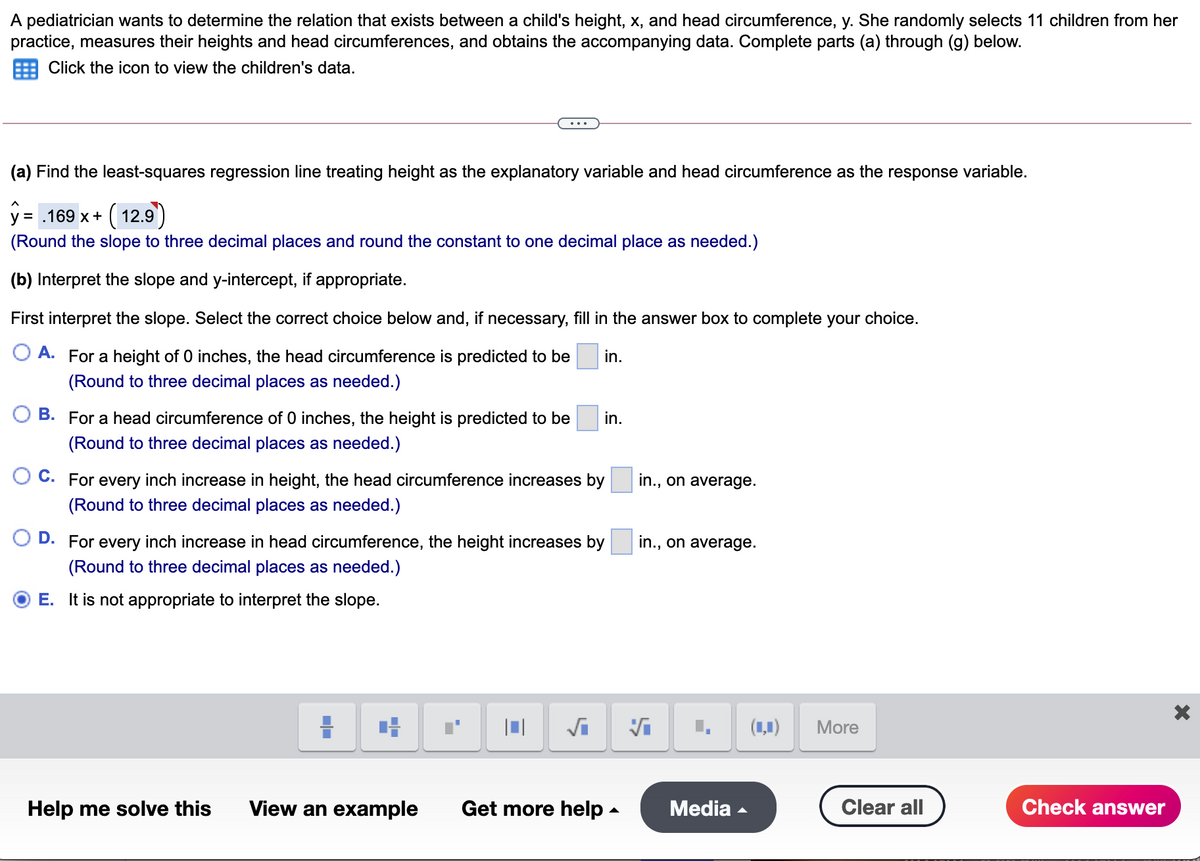A pediatrician wants to determine the relation that exists between a child's height, x, and head circumference, y. She randomly selects 11 children from her practice, measures their heights and head circumferences, and obtains the accompanying data. Complete parts (a) through (g) below. Click the icon to view the children's data. a) Find the least-squares regression line treating height as the explanatory variable and head circumference as the response variable. ( 12.9) y= .169 x + Round the slope to three decimal places and round the constant to one decimal place as needed.) (b) Interpret the slope and y-intercept, if appropriate. First interpret the slope. Select the correct choice below and, if necessary, fill in the answer box to complete your choice. O A. For a height of 0 inches, the head circumference is predicted to be in. (Round to three decimal places as needed.) O B. For a head circumference of 0 inches, the height is predicted to be in. (Round to three decimal places as needed.) O C. For every inch increase in height, the head circumference increases by in., on average. (Round to three decimal places as needed.) O D. For every inch increase in head circumference, the height increases by in., on average. (Round to three decimal places as needed.) O E. It is not appropriate to interpret the slope.
A pediatrician wants to determine the relation that exists between a child's height, x, and head circumference, y. She randomly selects 11 children from her practice, measures their heights and head circumferences, and obtains the accompanying data. Complete parts (a) through (g) below. Click the icon to view the children's data. a) Find the least-squares regression line treating height as the explanatory variable and head circumference as the response variable. ( 12.9) y= .169 x + Round the slope to three decimal places and round the constant to one decimal place as needed.) (b) Interpret the slope and y-intercept, if appropriate. First interpret the slope. Select the correct choice below and, if necessary, fill in the answer box to complete your choice. O A. For a height of 0 inches, the head circumference is predicted to be in. (Round to three decimal places as needed.) O B. For a head circumference of 0 inches, the height is predicted to be in. (Round to three decimal places as needed.) O C. For every inch increase in height, the head circumference increases by in., on average. (Round to three decimal places as needed.) O D. For every inch increase in head circumference, the height increases by in., on average. (Round to three decimal places as needed.) O E. It is not appropriate to interpret the slope.
Linear Algebra: A Modern Introduction
4th Edition
ISBN:9781285463247
Author:David Poole
Publisher:David Poole
Chapter7: Distance And Approximation
Section7.3: Least Squares Approximation
Problem 31EQ
Related questions
Question

Transcribed Image Text:A pediatrician wants to determine the relation that exists between a child's height, x, and head circumference, y. She randomly selects 11 children from her
practice, measures their heights and head circumferences, and obtains the accompanying data. Complete parts (a) through (g) below.
Click the icon to view the children's data.
(a) Find the least-squares regression line treating height as the explanatory variable and head circumference as the response variable.
y = .169 x+ ( 12.9)
(Round the slope to three decimal places and round the constant to one decimal place as needed.)
(b) Interpret the slope and y-intercept, if appropriate.
First interpret the slope. Select the correct choice below and, if necessary, fill in the answer box to complete your choice.
O A. For a height of 0 inches, the head circumference is predicted to be
in.
(Round to three decimal places as needed.)
B. For a head circumference of 0 inches, the height is predicted to be
in.
(Round to three decimal places as needed.)
C. For every inch increase in height, the head circumference increases by
in., on average.
(Round to three decimal places as needed.)
D. For every inch increase in head circumference, the height increases by
in., on average.
(Round to three decimal places as needed.)
E. It is not appropriate to interpret the slope.
(1,1)
More
Help me solve this
View an example
Get more help -
Media -
Clear all
Check answer
Expert Solution
This question has been solved!
Explore an expertly crafted, step-by-step solution for a thorough understanding of key concepts.
This is a popular solution!
Trending now
This is a popular solution!
Step by step
Solved in 2 steps

Recommended textbooks for you

Linear Algebra: A Modern Introduction
Algebra
ISBN:
9781285463247
Author:
David Poole
Publisher:
Cengage Learning


Algebra & Trigonometry with Analytic Geometry
Algebra
ISBN:
9781133382119
Author:
Swokowski
Publisher:
Cengage

Linear Algebra: A Modern Introduction
Algebra
ISBN:
9781285463247
Author:
David Poole
Publisher:
Cengage Learning


Algebra & Trigonometry with Analytic Geometry
Algebra
ISBN:
9781133382119
Author:
Swokowski
Publisher:
Cengage